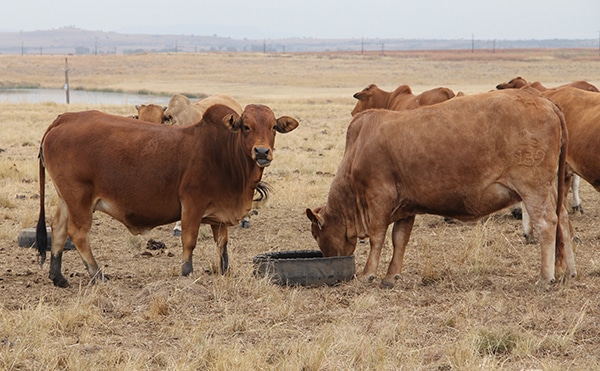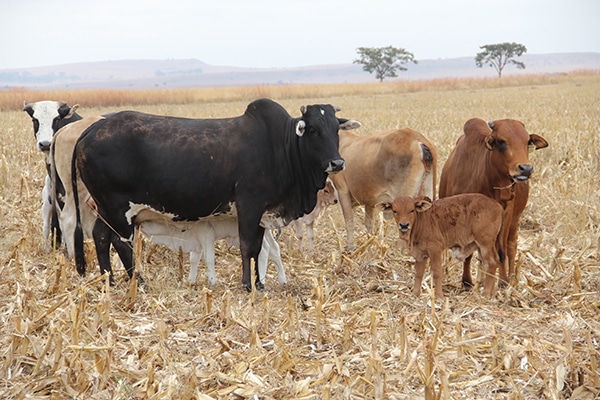The annual transition from winter to summer, and from summer to winter, gives rise to changes in the lick requirements of livestock. The specific region of the country in which a producer farms will ultimately determine the fundamentals of this change, but broadly speaking it boils down to the fact that livestock require a protein supplement in winter and a mineral supplement in summer, with phosphorus at the forefront of each.
If you pay close attention, your livestock will tell you exactly when and how their requirements start changing, says Dr Johan Meaker, a well-known retired researcher.
Seasonal transition licks
Although rainfall has the greatest influence on grass growth, heat units and daylight length also play an essential role. As a result, many farmers know that, depending on factors such as moisture, the environment and the effect of camps, grass will start growing as early as the end of July or beginning of August – usually in the wetlands first and initially very slowly.
It is only by mid to late November that grass in all regions will grow optimally. The best time to start incorporating transition licks is somewhere in between these dates, normally for a period of about six weeks.
“We mix equal amounts of summer and winter licks during this transition period, until the conditions allow for the animals to be moved entirely on to summer licks. The same applies to the end of summer when the protein requirements of animals increase.
“When licks are provided regularly, the animals will start looking for green grass by the end of September or beginning of October. Although very little green grass is available during this time, their intake of protein-filled winter licks will drastically decrease. This is how animals tell producers that they need more minerals. The moment more minerals are added to the lick intake will increase noticeably. Close observation is therefore the key to the efficient transition from winter to summer licks and vice versa,” says Dr Meaker.
His recipe for this transition period is the well-known Dundee winter lick, combined with a summer lick. He mixes equal amounts of both until the rainfall provides enough green grass.
Breeding cows’ nutritional needs
During a breeding cow’s production year, there is a critical period of approximately 100 days that determines whether conception will take place or not, according to the late Hendrik van Pletzen. This period comprises the last 30 days of gestation and the first 70 days of lactation.
Two major events occur during this period: A calf is born, and fertilisation takes place (marking the start of the next calving cycle). The nutritional requirements of the cow in terms of the quality and quantity of grazing during this period are almost on par with her requirements during the rest of the production year.
First calvers, which are still growing until they reach maturity, have even higher nutritional requirements during the 100 days. The high nutritional requirement is a given, but fodder flow planning and the supply of grazing during this time is often lacking.
If cows are in poor condition at calving, their recovery will be slow – several researchers have pointed out that lean cows are known for poor reconception. The opposite is also true and cows in good condition at calving have more reserves recover faster post-calving and come into oestrus much sooner.
Production licks
The target condition score at calving should be 3 to 3,5 (on a scale of 1 to 5) and production licks can contribute towards achieving this goal. Production licks are expensive as their intake is almost three times that of maintenance licks. The period during which they are supplied should be as short as possible, without compromising efficiency. However, a cow that skips means a greater loss in income than the cost of a strategically used production lick.
According to renowned animal nutrition specialist of Kaonne Investments, Dr Hinner Köster, production lick usage should be linked to specific goals. Questions to ask, for example, include: Is your goal with production licks to achieve growth of 500 to 1 000g per day in weaner calves? Do you want to support lactating cows by helping them regain condition, or to maintain their condition until the next calving season so as to promote quick reconception? Or do you want to stimulate good milk production levels in order to produce heavier weaner calves?
Each of these goals, he says, sets different requirements for a production lick. “The combinations and levels of energy and protein types can therefore differ significantly, and the amount of lick ingested per animal per day will also differ. In some cases, 800g production lick per animal per day will suffice, but in other cases, it needs to be 1,5 to 2kg per day. These differences must be managed very carefully to harness the advantages of different production licks.”
Maintenance vs production licks
It is important, Dr Köster emphasises, to draw a clear distinction between the principles and goals that apply to maintenance and production licks.
“One of the key goals of a production supplementation programme is to help stimulate the utilisation of the nutrients in the roughage the animal ingests. Here the production lick follows the same route as a maintenance lick: It contains nutrients that stimulate the microbes in the animal’s digestive system, leading to the digestion of the roughage’s fibre component (energy fraction); enough nutrients from the roughage are therefore available to meet the maintenance function, as well as part of the growth function (depending on the quality of roughage) of the animal.

“Supplements rich in rumen-degradable protein such as oilcake, and non-protein nitrogen (NPN) sources, such as urea and ammonium sulphate, will improve grass utilisation and consequently livestock performance, especially on winter grazing. NPN sources are cheaper and up to a certain intake level they are just as capable of stimulating the intake and digestion of grass, than supplements based on natural protein. However, once that level is reached, additional natural protein is needed for maximum performance.”
A production lick, he elaborates, contains additional energy, based on the fact that grass cannot provide the total energy needed to reach a specific production goal. If the energy requirements of young, growing or lactating beef cattle, especially first calvers, exceed the energy the grass provides, extra energy needs to be sourced in the form of a typical ‘production supplement’. This can be either better-quality grass (possibly cultivated grazing) or a protein/grain-based supplement.
Grain will have less of an effect on the improvement in grass’ intake and digestion, especially in winter, but will improve performance directly as it supplements the shortages in the roughage when higher production goals are required.
Summer vs winter production licks
“Of course, the difference between winter and summer production licks are quite significant. In summer, energy is the limiting factor, and greater emphasis is therefore placed on energy supplementation. The approach in winter is to first focus on the protein supplement and then to balance the energy levels.

“In summer production licks more emphasis is placed on the rumen bypass protein in the protein fraction, as the natural protein in the grass provides enough rumen-degradable protein for microbial function in the rumen. Any extra proteins, in combination with energy, that are given in a bid to achieve higher production will therefore be mainly in the form of rumen bypass protein.
“Lastly, if you do not have enough roughage available, then any form of lick supplementation will be of little value. It is crucial to have some form of roughage available or to buy it in,” concludes Dr Köster. – Izak Hofmeyr, Stockfarm
For more information or a list of references, send an email to Izak Hofmeyr at izak@plaasmedia.co.za.







